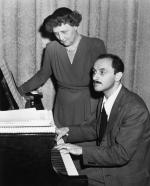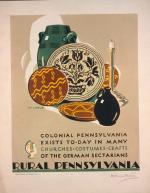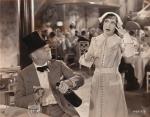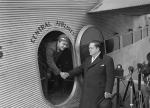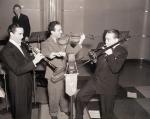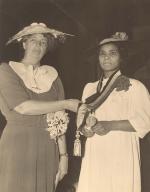Chapter 4: Popular Culture and Society in the 1930s
"It's clear to me that the conception of music in society . . . is dying of acute anachronism; and that a fresh idea, overwhelming in its implications and promise, is taking hold. Music must have a social as well as an artistic base; it should broaden its scope and reach not only the select few but the masses."
So wrote Philadelphia-born playwright Marc Blitzstein in 1935, two years before his controversial play, The Cradle Will Rock, premiered in New York. Blitzstein set his play in a fictional town not unlike Homestead, Pennsylvania, where, in fact, a well-publicized CIO organizing drive had taken place in 1936. And he exhorted working men and women to organize and and "rock the cradle" of America's traditional - and corrupt - social institutions. Working-class audiences loved the play, but New Deal opponents in corporate board rooms and in the halls of Congress considered it subversive. They were outraged, not just by the play's message, but because it was funded by the Works Progress Administration's (WPA) Federal Theater Project.
America's culture, like its politics, was transformed dramatically during the Great Depression. Disillusioned and often out-of-work Americans became much less deferential to business interests and upper-class elites than they had been during the 1920s, more open to new ideas and social criticism, and more tolerant of minorities' and women's rights. America's artists both reflected change and promoted it. Inspired by the lives of everyday Americans, they worked tirelessly and productively to build their dream that common people could create a better, more inclusive, and more open society.
WPA projects provided employment for American artists in many different fields, from painting to writing to music. Much of this work was inspired by local history and tradition, leading literary critic Alfred Kazin to proclaim that "never before did a nation seem so hungry for news of itself." In Pennsylvania, unemployed writers hired by the Federal Writers' Project produced a guidebook to the state (1940) and for the city of Erie (1938). And the Federal Art Project employed artists to create murals in nearly one-hundred Pennsylvania post offices, and to bring art to the people,
Cultural change during the Great Depression was also driven by market forces and emerging technologies, especially talking pictures and radio, which emerged as a powerful political tool exploited brilliantly by President Roosevelt in his fire side chats, and by Detroit's Father Coughlin, who attracted millions of listeners by railed against Roosevelt's New Deal in anti-Semitic and often pro-Fascist rants.
A plunge in attendance at
Tired of Hollywood films that celebrated the lives of the wealthy, movie audiences in Pennsylvania and across the country turned to films that presented stories of people from different cultural backgrounds struggling to make their livings, including sympathetic portrayals of gangsters and rebellious outsiders, and anarchic, ribald comedies. Working class, ethnic audiences could easily relate to Philadelphian
Hollywood films of the 1930s also celebrated a new kind of hero, an American Everyman at odds with a corrupt establishment. And no Hollywood star portrayed this character better than
The movies both reflected and encouraged changes taking place outside the theater, changes apparent in the lives of American women, as well as men. Relief work continued to provide women service opportunities to help their communities. In Philadelphia,
In literature,
While American writers were grappling with the challenges of making sense of the broken nation in words, popular music was uplifting the spirits of millions of everyday Americans. At first, the Great Depression nearly killed the American record industry. But radio, which became an essential appliance in many households during the 1930s, brought the music of America into homes across the nation. Drawn to "swing," an easy-flowing and dance friendly style of jazz and big band music, Depression-era youths pushed the
In the 1930s, radio also helped politicians bring their messages directly to the American people. In the late 1930s, Governor George Earle delivered his own "little" Fire Side chats to the citizens of Pennsylvania, and Detroit's Father Coughlin emerged as a political force in the state through his weekly radio broadcasts.
During the Great Depression black Pennsylvanians, too, continued to develop their own stars. While the Nicholas Brothers from Philadelphia were tapping up a storm in Hollywood musicals, the powerful
Despite the economic hardships, Americans in the 1930s also continued their love affair with the future and with modern architecture and design. Americans marveled at the Roadable Autogiro, a two-seat plane with foldable rotor blades that promoter





